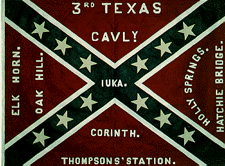|

This
is the 3rd variation of the 3rd Texas Cavalry Regimental Flag.
This flag measures 421/2 inches by 52 inches. This flag is
believed to have been used by the 3rd Texas Cavalry beginning
in early 1864. The flag was probably inspired by General Joe
Johnston who saw flags of Forrest's Cavalry and Polk's Command
in early 1864. He ordered several produced but with smaller
stars. The 3rd Texas Cavalry were probable influenced by that
as they were fighting in Atlanta and elsewhere during this
period. This flag now proudly rest in the Texas State Archives
at the state capital in Austin, Texas. It has been fully restored
and cased. It is said to be in reasonably good condition in
the storage facilities.
The
National Flags of the Confederate States of America

The
First National flag (left) that was referred to as the stars
and bars. In was officially adopted in March of 1861 and was
the official national flag of the Confederacy until May of
1863.It was designed by Nicola Marshal of Alabama. When it
was first adopted it had only seven stars as it represented
the first seven states to secede. Later it was augmented with
all 13 states of the Confederacy that were represented each
by an individual star. During battles, with all the smoke
and fog, it was sometimes confused with the stars and strips.
The
Second National flag (center) was adopted in May of 1863 and
was called the "Stainless Banner." It was used until
April of 1865. It replaced the stars and bars because the
original flags were too similar to the United State's Stars
and Strips. The new Stainless banner was named such because
of its plain white field. Its red canter was crisscrossed
by a white edged dark blue saltire (Saint Andrew's Cross)
emblazoned with the thirteen white stars. Unfortunately, when
in calm weather it hung limp and was confused with a white
flag of surrender.
The
3rd National Flag (right) was adopted in April of 1865.Reportedly,
the 2nd flag, when lying still, with no wind to extend it,
was mistaken for the white flag of surrender. Thus, a large
red border was placed at the end so not to suggest any surrender
was in the making. It saw almost no service during the war.

|